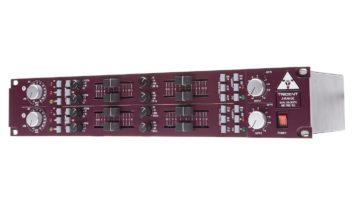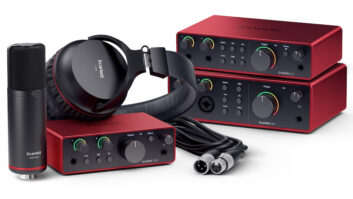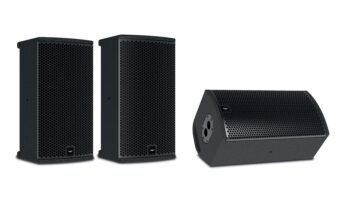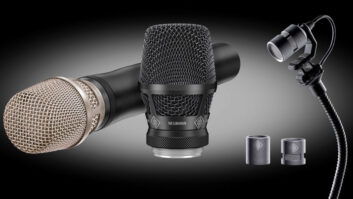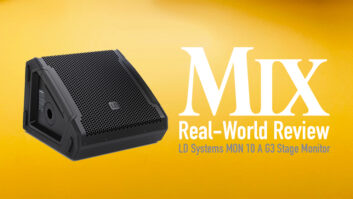The story of the Trident A Range is an interesting one. Initially designed for London’s Trident Studios by Malcolm Toft and Barry Porter in the early ’70s, the A Range console was also produced for sale, though only 13 were actually built. But the A Range spawned an entire generation of consoles, and many hit records were tracked and mixed on its direct descendant, the Trident Series 80. Today, Toft is still building consoles based on the Series 80, including the Series 980, which was used to record the last three Radiohead releases. Another Series 80 derivative is the Trident-MTA Series 80B module, a rackmount version of the Series 80 channel strip. [Note: Toft recently formed an alliance with JOEMEEK manufacturer Fletcher ElectroAcoustics, to form Trident-MTA to offer products formerly sold under the MTA (Malcolm Toft Audio) name, such as the 980, the 80B and the A Range. Meanwhile, former Trident designer John Oram bought the original Trident Audio Developments name and is marketing his own line of Trident-branded modules and consoles, but there is no connection between the two companies. — Ed.]
Though it had a very limited run, the Trident A Range console gained a reputation for its very distinct and pleasant sound with a very “musical” EQ section. Along with channel strips from early Neve and Helios consoles, original Trident A Range modules have kept a healthy resale value and are much sought after by engineers who like to combine old-school analog gear with bleeding-edge digital recording technology. With this in mind, Toft unearthed the original blueprints for the Trident A Range console and created a 2-channel rackmount preamp and EQ combo based on the A Range, with key components updated to allow for less noise. After putting the unit through its paces, I’m happy to report that the near-mythical status accorded the A Range is indeed based on fact.
The new A Range mic pre amplifier section has an 11-position Gain switch with a transformer-coupled input. The unit is switchable between mic/line and has an LED indicator. There is also a 48V Phantom switch, a Phase Reverse switch and a red overload indicator at the input stage.
Except for the addition of an in/out LED light, the layout of the filters and EQ is identical to those in the original A Range modules. The filters consist of a set of three highpass and three lowpass filters that are all discrete, Class-A amplifier second-order filters. The lowpass filters are fixed at 9, 12 and 15 kHz, while the highpass filters are fixed at 25, 50 and 100 Hz. The filters are always in circuit and are not affected by the EQ in/out switch.
All EQ sections are authentic, inductive-type with 15dB lift/cut applied with 70mm linear faders. The EQ frequency is selected by means of a 4-position switch per band. The low frequencies are 50, 80, 100 and 150 Hz. The low-mid frequencies are 250 Hz, 500 Hz, 1 kHz and 2 kHz. The high-mid frequencies are 3, 5, 7 and 9 kHz. The high frequencies are 8, 10, 12 and 15 kHz.
One significant difference from the original A Series module is in the output gain control, which allows the output gain to range from off to a peak output of +28 dB, enough to drive any professional equipment.
The mic preamp is very warm and wide-open sounding, especially on the lower and upper mids. I used the unit on a wide variety of instruments and voices, including male and female voices, electric and acoustic guitar, bass, acoustic piano and Wurlitzer piano, drums, drum overheads and room mics. I used all microphone types, ranging from condensers to ribbons to dynamic, and found that the unit’s overall coloration is similar to a set of racked Neve 1073s, with maybe a bit more emphasis on the upper-mids than the Neves.
Overall, the EQ is extremely pleasant sounding (okay, I’ll say it: very “musical” sounding). It definitely has a unique sound that recommended it over quite a few other processors in mix situations. As is the case on the original A Range, the “Q” value on the EQ section is fixed and quite wide by today’s standards. (The manual lists a value of “1.2, varying slightly with frequency.”) So if you’re looking for a precision carving tool, the A Range unit is not going to fill that need. However, the frequency options available were more than enough to work in a wide range of mixing situations. I had a blast seeing just how much I could tweak various types of program material before the sound quality began to be a bit harsh.
With 20- to 30-year-old racked Neve preamp/EQ combo packages going for around $6,000, the appearance of the updated A Range module as an additional “vintage” tool for under $3,699 is sure to make a lot of engineers very happy. Reinventing the past can be a good thing, and in this case, Malcolm Toft and Ted Fletcher should be congratulated on a job well done.
Trident-MTA, distributed in the USA by PMI Audio, 23773 Madison St., Torrance, CA 90505; 310/373-9129; fax 310/373-4714; www.pmiaudio.com.
Composer/producer Walt Szalva owns Planet 3 Productions in San Francisco.

